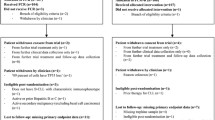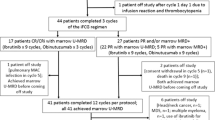Abstract
The fludarabine plus cyclophosphamide (FC) regimen was reported to be superior to chlorambucil or fludarabine alone in terms of complete response (CR), overall response (OR) and progression-free survival (PFS) in previously untreated patients with chronic lymphocytic leukaemia (CLL). In the present study, we compared the efficacy and toxicity of FC administered through oral and intravenous route in 65 untreated patients affected by advanced CLL. No statistical differences were noticed between the two routes of administration in terms of OR, PFS, time to re-treatment (TTR) and overall survival (OS) of analysed patients. We also assessed the influence on the clinical outcome of the mutation status of the immunoglobulin variable region heavy chain (IgVH) gene, of the cytogenetic abnormalities and of the expression of ZAP70 and CD38 in patients' primary samples. Among the 58 evaluable patients, 31 (53%) achieved a CR and 18 (31%) a partial response. The median PFS was 35 months, median TTR was 42 months and median OS was not reached after 45 months (range, 1–161). A significantly lower OR rate was noticed in patients with high-risk cytogenetic abnormalities (del 17p, del 11q). In this study, high-risk cytogenetic abnormalities and unmutated IgVH genes were independent predictors of TTR. These results underline the importance of biological stratifications in front-line treatment of CLL patients. We confirm that FC is an effective regimen with mild toxicities; it could be recommended for patients with low-risk biological parameters who represent, in our experience, about 30% of the total.


Similar content being viewed by others
References
Bellosillo B, Villamor N, Colomer D, Pons G, Montserrat E, Gil J (1999) In vitro evaluation of fludarabine in combination with cyclophosphamide and/or mitoxantrone in B-cell chronic lymphocytic leukemia. Blood 94:2836–2843
Koehl U, Li L, Nowak B (1997) Fludarabine and cyclophosphamide: synergistic cytotoxicity associated with inhibition of interstrand cross-link removal. Proc Am Assoc Cancer Res 38:2, 10a
Eichhorst BF, Busch R, Hopfinger G (2006) Fludarabine plus cyclophosphamide versus fludarabine alone in first-line therapy of younger patients with chronic lymphocytic leukemia. Blood 107:885–891
Catowsky D, Richards S, Matutes E et al (2007) Assessment of fludarabine plus cyclophosphamide for patients with chronic lymphocytic laeukemia (the LRF CLL4 trial): a randomized controlled trial. Lancet 370:230–239
O’Brien S, Kantarjian HM, Cortes J, Beran M, Koller CA, Giles FJ et al (2001) Results of the fludarabine and cyclophosphamide combination regimen in chronic lymphocytic leukemia. J Clin Oncol 19:1414–1420
Flinn IW, Neuberg DS, Grever MR, Dewald GW, Bennett JM, Paietta EM et al (2007) Phase III trial of fludarabine plus cyclophosphamide compared with fludarabine for patients with previously untreated chronic lymphocytic leukemia: US intergroup trial E2997. J Clin Oncol 25(7):793–798
Hallek M, Fingerle-Rowson G, Fink AM et al (2009) First-line treatment with fludarabine (F), cyclophosphamide (C), and Rituximab (R) (FCR) improves overall survival in previously untreated patients with advanced chronic lymhocytic leukemia (CLL): results of a randomized phase III trial on behalf of an international group of investigators and the german CLL study group. Blood 114(22):abs 535
Slilgenbauer S, Zenz T, Winkler D et al (2008) Genomic aberrations, VH mutational status, and outcome after fludarabine and cyclophosphamide (FC) or FC plus Rituximab (FCR) in the CLL8 trial. Blood 112(11):abs 781
Robak T, Dmoszynska A, Solal-Céligny P et al (2010) Rituximab plus fludarabine and cyclophosphamide prolongs progression-free survival compared with fludarabine and cyclophosphamide alone in previously treated chronic lymphocytic leukemia. J Clin Oncol 28(10):1756–1765
Cheson BD, Bennet JM, Grever M, Kay N, Keating MJ, O’Brien S et al (1996) National cancer institute-sponsored working group guidelines for chronic lymphocytic leukemia: revised guidelines for diagnosis and treatment. Blood 87(12):4990–4997
Hallek M, Cheson BD, Catovsky D et al (2008) Guidelines for the diagnosis and treatment of chronic lymphocytic leucemia: a report from the international workshop on chronic lymphocytic leukemia updating the national cancer institute-working group 1996 guidelines. Blood 111(12):5446–5456
Laurenti L, Tarnani M, De Padua L et al (2008) Oral fludarabine and cyclophosphamide as front-line chemotherapy in patients with chronic lymphocytic leukemia. The impact of biological parameters in the response duration. Ann Hematol 87:891–898
Dohner H, Stilgenbauer S, Benner A et al (2000) Genomic aberration and survival in chronic lymphocytic leukemia. N Engl J Med 343:1910–1916
Ivanovski M, Silvestri F, Pozzato G et al (1998) Somatic hypermutation, clonal diversity, and preferential expression of the VH 51p1/VL kv325 immunoglobulin gene combination in hepatitis C virus-associated immunocytomas. Blood 91:2433–2442
Crespo M, Bosh F, Villamor N, Bellosillo B, Colomer D, Rozman M (2003) ZAP-70 expression as a surrogate for immunoglobulin-variable-region mutations in chronic lymphocytic leukemia. N Engl J Med 348(18):1764–1775
Damle RN, Wasil T, Fais F et al (1999) Ig V gene mutation status and CD38 expression as novel prognostic indicators in chronic lymphocytic leukemia. Blood 94:1840–1847
Cazin B, Divine M, Lepretre S, Travade P et al (2008) High efficacy with five days schedule of oral fludarabine phosphate and cyclophosphamide in patients with previously untreated chronic lymphocytic leukaemia. Br J Hematol 143:54–59
Tam CS, O’Brien S, Wierda W et al (2008) Long-term results of the fludarabine, cyclophosphamide, and Rituximab regimen as initial therapy of chronic lymphocytic leukemia. Blood 112:975–980
Author information
Authors and Affiliations
Corresponding author
Rights and permissions
About this article
Cite this article
Laurenti, L., De Padua, L., Tarnani, M. et al. Comparison between oral and intravenous fludarabine plus cyclophosphamide regime as front-line therapy in patients affected by chronic lymphocytic leukaemia: influence of biological parameters on the clinical outcome. Ann Hematol 90, 59–65 (2011). https://doi.org/10.1007/s00277-010-1025-y
Received:
Accepted:
Published:
Issue Date:
DOI: https://doi.org/10.1007/s00277-010-1025-y




